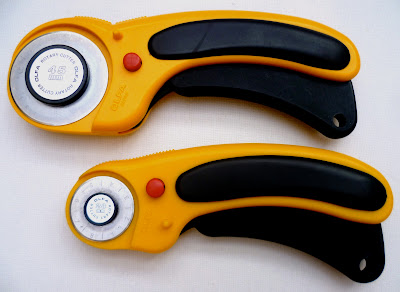I am using a different technique for piecing the spoon- foundation paper piecing. This is where you stitch your seams through a thin paper foundation. Its plus points are that it is very accurate, and requires less preparation than the freezer paper method. Its downsides are that you are working in reverse/mirror image (you'll see what I mean later), you cannot control how you iron your seams, it is harder to get the grain of your fabric right or to fussy cut, it is more wasteful of fabric and it is less flexible when designing patterns. I like the accuracy but I hate sewing through paper and I don't enjoy picking the bits of paper off at the end. No freezer paper is needed for this technique. We will be foundation piecing the spoon in two sections.
Start by printing out
this PDF pattern onto thin paper. Roughly cut the two sections out but keep the seam allowances intact. It can help to print two copies and cut one of these up to act as a pattern piece guide but remember to allow for the seam allowance too if you do this.

We are starting with section B: the head of the school. You will need a piece of grey fabric that covers the whole of the spoon area including the seam allowance and a little beyond. If you put the fabric behind the paper and hold it up to the light you will be able to see if your fabric is big enough. Scroll further down for a photo of this. Secure with a pin. If your fabric has right side and wrong side, the right side faces down and the paper is pinned onto the wrong side. Next, you need to cut triangles big enough for pieces 15,16,17,18 plus seam allowances. You can see the size of mine- they are on an inch grid. You always need to go a bit bigger with this method as you will trim the seams down as you stitch.

Take a triangle and place it under the paper, right sides together with the spoon fabric. The corner of the triangle lies inwards toward the centre of the spoon. It takes a while to get the hand of this, remember the fabric will open out after your stitch. Place a pin along the seam line- this is where your stitches will go.
Check that the fabric is big enough, the pin will hold it in place, just flip the triangle outwards, it should extend to the seam allowance at least.
This is how it looks on the reverse- this is going to be the right side so you are working in reverse and in mirror image!
Flip everything back so the paper is on top and the triangle is flat underneath with the right angle corner facing inwards. You are ready to stitch. You need small stitches- 1.5mm, a larger needle helps to perforate the paper and you could use a thicker thread rather than a piecing weight- mine held up fine though. For a lot of foundation piecing patterns you need to start and stop exactly with the seam line and secure but that is not necessary with this simple shape. You can start in the seam allowance and will not need to secure your stitches if you choose this.
You will need to flip over and press your seam, trim the seam allowance to quarter inch with scissors (scroll further down for a picture of this) and press the triangle outwards. Then repeat with triangles 16, 17, 18. It should look like this.
Trim the outside edges to line up with the dotted line of the seam allowance. The spoon head section is complete but do not remove the paper yet!
We are working on the handle (section C) next. Just like before, find a piece of grey fabric that covers the whole of the handle area (19) including the seam allowance and a little beyond. If you put the fabric behind the paper and hold it up to the light you will be able to see if your fabric is big enough. Secure with a pin along the centre of piece 19.
We are working on the long side pieces 20 and 21 next, so cut out two pieces of background fabric large enough to cover each area plus seam allowances all round. Starting with piece 20, hold right sides together so that the fabric extends at least quarter inch over the seam line and the lies behind piece 19. Pin through the paper and along the seam line , flip over and check the fabric opens out to cover piece 20 plus the seam allowance. Stitch along the line, you can start in the seam allowance at the top and stitch into the triangle 23, if you stitch a long way it is going to be hard to trim the seam so a quarter inch will do.
Flip over, press, trim the seam, open out and press again, In this photo I have added pieces 20 and 21 and I have started to trim one of the seams.
Cut and add pieces 22 and 23 just like you did with the corner triangles of the head of the spoon. It should look like this untrimmed,
and like this one you have trimmed up to the seam allowances.
You now need to join the head and handle together, place the paper sides together, stitch right along the lines at the top of the handle and the bottom of the spoon head
Open out, and carefully peel off the paper and give the spoon a good press.
Your pieced sections are finished.
Ready to put the whole thing together? I'll be back soon...
Ready to win this mug rug? Giveaway soon...














































